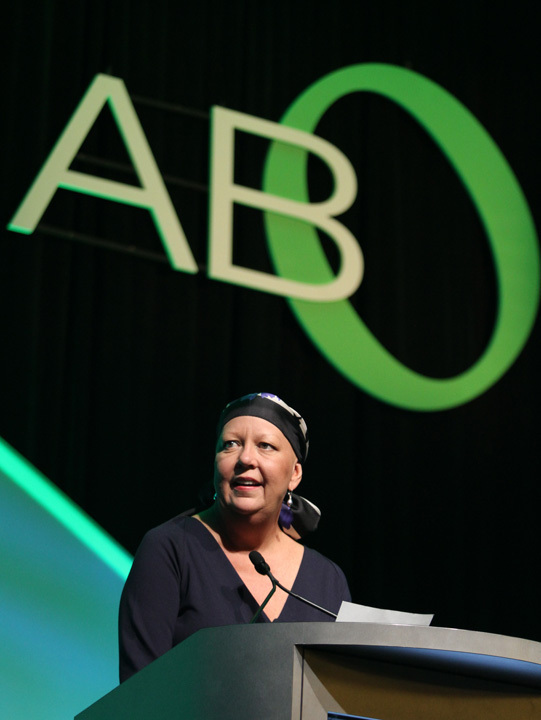Algae Biomass Summit: producers say commercialization is close




September 25, 2012
BY Tom Bryan
Small American companies are directing the global algae industry’s commercialization approach. With Big Oil, Big Food and big money behind them, U.S. algae startups continue to scale up, build out, and tap into the infrastructure of willing industrial hosts from Iowa to Indonesia.
The take-away message from the opening session at the 2012 Algae Biomass Summit in Denver was that algae production is very close to commercial deployment, but shoring up government support mechanisms for algae-derived products—and removing regulatory barriers that hinder algae cultivation—threaten to keep the industry from going big in the near term.
Presentations at the 6th annual ABS began Monday afternoon following preconference tours of the National Renewable Energy Laboratory and the MillerCoors Brewery, both in nearby Golden, Colo. NREL’s Phil Piekos and Dana Christensen welcomed the nearly 800 ABS attendees before Sen. Mark Udall, D-Colo., addressed the audience. Udall emphasized the need for greater domestic energy security, saying the U.S. Department of Defense is the largest user of fossil fuels in the world, consuming more than 320,000 barrels of fossil fuels every 24 hours at an expense of about $30 million per day. “Developing renewable fuels is a strategic and tactical necessity,” Udall said, pointing to the rising costs of procuring, shipping and protecting America’s fuel supplies globally. “No one understands the true cost of fuel more than our combat personnel on the ground in the darkest corners of the world.”
Udall, Pienkos and others lauded Algae Biomass Organization Executive Director Mary Rosenthal for her courage and perseverance during her ongoing battle with cancer. “You’re an inspiration to all of us,” said Pienkos before Rosenthal momentarily addressed the audience.
Jim Lane, editor of Biofuels Digest, led a panel discussion with representatives of five algae production companies including Sapphire Energy, BioProcess Algae, Cellena, Heliae and Algenol biofuels.
Tim Zenk, vice president of corporate affairs for Sapphire Energy, reported that his firm continues to pursue an integrated approach that includes algal cultivation, harvest and extraction. “We’re making tremendous progress,” Zenk said, explaining that Sapphire has harvested 31 million gallons of algae to date and is beginning to prove out algae’s crop-like cultivation characteristics. “We’re proving that you can grow this like a crop,” he said. “We’ve had a full year of continuous harvests.”
Advertisement
BioProcess Algae’s Tim Burns said his company’s story is “all about co-location” and going after what he called the “insatiable demand” markets: high-value feed ingredients, first, and advanced biofuels later. Burns touted the strategic partnership BioProcess Algae has with its host industrial partner, Green Plains Renewable Energy, a corn ethanol plant in Shenandoah, Iowa. Suggesting that BioProcess Algae is approaching commercial-scale readiness, Burns said the company will have salable product coming off its facility in November. “People ask me what the next six months will look like and I tell them, ‘Like the next six years,’” said Burns, alluding to the readiness of BioProcess Algae’s technology and its aggressive market development and build-out strategy.
Martin Sabarsky said Cellena is also pursuing co-location partners, primarily targeting larger CO2 sources such as power plants. Like other algae production companies, Cellena is pursuing multiple algae-derived products, including fuel, but focusing on the large-scale production of high-value feed and food ingredients. “We’ve now begun to generate meaningful quantities of Omega 3 oils,” Sabarsky said, adding, “It’s going to take more than just fuel to make this work. It’s going to take a whole suite of products that, for us, will include fuel.”
Heliae’s Dan Simon said he is encouraged by the industry’s approaching commercial readiness. “This is the first algae show that I’ve been at where we are actually starting to see some scale,” he said, explaining that Heliae is expanding its Gilbert, Ariz., campus for expansion. Heliae, which is backed by members of the Mars family, which own Mars Inc., and one other Indonesian company, recently leased an additional 20 acres of land in preparation for the construction of a large-scale algae production facility. “We’re raising $30 million, doubling our space, building a commercial-scale facility, expanding our patents and building a world-class personnel team,” Simon said.
Notably, Simon said Heliae does not intend to be a pure-play algae producer long term. “We’d like to be a service company that supports the algae industry and facilitates its growth,” he said.
Algenol Biofuels CEO Paul Woods recapped his company’s unique production model, which utilizes algae for the continuous production of ethanol. “Each cell is a tiny ethanol factory,” Woods said of his technology. Algengol has had relative success raising equity, already landing $150 million and now pursuing another $150 million to $200 million to bring its Florida facility to commercial scale. “It’s been a hell of a year for the people of Algenol,” Woods said, explaining the company’s ambitious equity goals and also announcing new strategic partnerships that will allow Algenol to produce biojet fuel and renewable diesel, in addition to ethanol, from algae.
Advertisement
While algae production is now technologically feasible at commercial scale, the panelists agreed that government support mechanisms for advanced biofuels and biobased products must remain intact, and regulatory barriers, mostly on the state level, must be overcome. “We need parity for algae, and we need equal footing in the RFS,” Zenk said. “But we need to tread lightly because keeping the RFS intact is critical.”
Simon agreed, saying, “We need to get behind the RFS and make it work for us.” But, he warned, “Enemies will emerge when algae starts to make an impact politically.”
Woods’ chief concern appeared not to be market mechanisms for algae products but rather the removal of regulatory barriers that threaten to prevent the industry from getting off the ground. Having previously overcome difficult environmental regulations in Florida, Woods said the industry needs to fight for common environmental regulations that small companies can navigate. “If regulations are insurmountable, this just isn’t going to happen,” he said.
The panelists had varying opinions on the subject of capital. Algenol has so far steered clear of government loan guarantees and, in fact, debt financing altogether, instead leveraging its strong technology to raise large amounts of capital, much of it from international sources. “It comes down to how strong is your technology, and can it withstand due diligence,” Woods said. “Our technology and our partnerships put us in a good position.”
Simon said Heliae has also had success raising equity from overseas investors, recently bringing on a major Indonesian partner. “In America, capital for clean energy comes in bundles or waves,” Simon said, explaining the current timidity of U.S. equity. “Asia and Europe have a much more long-term approach—and they always have.”
Zenk said U.S. private equity is shying away from clean energy right now because of the uncertainty of government programs that support renewables. “Nothing scares investor more than the rhetoric coming out of Washington, D.C., these days,” Zenk said. “We need to get that stability back.”
Upcoming Events





